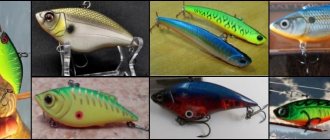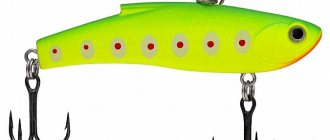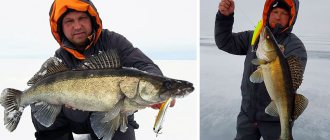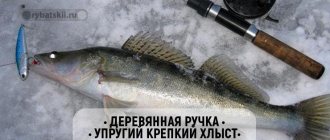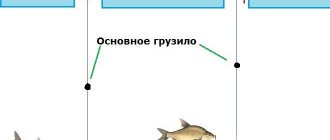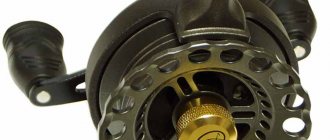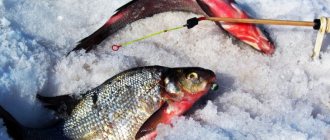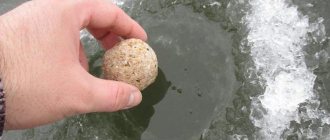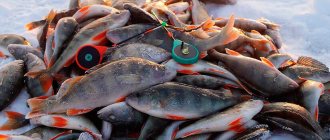What is a rattlin for ice fishing
An artificial bait-balancer in the form of a small fish, repeating its shape, but flattened on the sides. Rattlin means "rattling" in English. Initially, the bait was intended specifically for winter fishing, for sheer trolling. The bait does not have a blade, but is equipped with a rattle, which is located inside the body, and the leash is attached to the back. The package includes two tee hooks; double or single hooks are less common.
One is located in the tail section, the second is on the “belly”. This type of wobbler or vib, as it is also called, is characterized by frequent play with slight fluctuations. When fishing, during retrieval, the body of the bait takes on an almost vertical position. When a fisherman smoothly reels in the fishing line, the vib maintains its position, which distinguishes it from other gear.
DIY rattlins/handmade rattlins.
Do-it-yourself rattlins/handmade rattlins. A short review on making rattlins from liquid plastic and PVC... Casting plastic baits: https://www.youtube.com/watch?v=Py3e1J5QcSM Alex Mercy plays the guitar https://www. youtube.com/user/MrGuitarchild — — — — — — — — — — — — — — — — — — — — — — — — — — — — — — — — — — — — — — — — — — drop on tee https://youtube.com/watch?v=se46ORy8DN4 — — — — — — — — — — — — — — — — — — — — — — — — — — — — — — — — — — — — — — — making a spoon spoon https://www.youtube.com/watch?v=j8tCYSXryw4 — — — — — — — — — — — — — — — — — — — — — — — — — — — — — — — — — — — — — — -о Predator bait “Wobbler Blade” https://www.youtube.com/watch?v=v7xE0Yyb66E — — — — — — — — — — — — — — — — — — — — — — — — — — — — — — — — — — — — — — — — — — — Bait pear, bullet https://www.youtube.com/watch?v=Sr3-fif_lVc — — — — — — — — - - - - - - - - - - - - - - - - - - - - - - - - - - - - - - - - - - - - With ultralight in search of a toothy one https://www.youtube.com/watch ?v=SxbcSiJttz8 - - - - - - - - - - - - - - - - - - - - - - - - - - - - - - - - - - - - - - - - - - - - Two-Leaf Spinner https ://www.youtube.com/watch?v=Fi7XYlgj-X8 — — — — — — — — — — — — — — — — — — — — — — — — — — — — — — — — — — — — — — — — — Making corkscrews for silicone baits https://www.youtube.com/watch?v=evw6twi29rU — — — — — — — — — — — — — — — — — — — — — — — — — — — — — — — — — — — — — — — — — — — — — Making micro turntables https://www.youtube.com/watch?v=drPGsczKHu0 — — — — — — — — — — — — — — — — — — — — — — — — — — — — — — — — — — — — — — — — — — — — — — — DIY PVC boat anchor https://www.youtube.com/watch? v=T5FDUxegyWM - - - - - - - - - - - - - - - - - - - - - - - - - - - - - - - - - - - - - - - - - - - - - - - How to make a spinnerbait https://www.youtube.com/watch?v=kp-yDzb81v4 — — — — — — — — — — — — — — — — — — — — — — — — — — — — — — — — — — — — — — — — — — — — — Bibrax turntable manufacturing https://www.youtube.com/watch?v=LradSVcWY4I — — — — — — — — — — — — — — — — — — — — — — — — — — — — — — — — — — — — — — — — — — — — Croatian egg or its DIY alternative https://www.youtube.com/watch?v=dxRLz_44eRc — — — — — — — - - - - - - - - - - - - - - - - - - - - - - - - - - - - - - - - - - - - - Spinner in 10 minutes https://youtube.com/watch?v =XlPMIxNQTM0 - - - - - - - - - - - - - - - - - - - - - - - - - - - - - - - - - - - - - - - - - - - - - Making a petal for a pinwheel. Assembling the turntable https://www.youtube.com/watch?v=hTmQo9ogTYY — — — — — — — — — — — — — — — — — — — — — — — — — — — — — — — — — — — — — — — — — — — — — — — — — How to make a core for a turntable https://www.youtube.com/watch?v=r7sDZXsJlzk — — — — — — — — — — — — — — — — — — — — — — — — — — — — — — — — — — — — — — — — — — — — — — — Catching perch with a bombard https://www.youtube.com/watch?v=kia3VwiDhEI — — - - - - - - - - - - - - - - - - - - - - - - - - - - - - - - - - - - - - - - - - - - - - - - - Fishing lure release https: // https://www.youtube.com/watch?v=VSDQO4LKWVY — — — — — — — — — — — — — — — — — — — — — — — — — — — — — — — — — — — — — — — — — — Croatian egg or its alternative https://www.youtube.com/watch?v=dxRLz_44eRc — — — — — — — — — — — — — — — — — — — — — — — — — — — — — — — — — — — — — — — — — — — VK page https://vk.com/id351392250 — — — — — — — — — — — — — — — — — — — - - - - - - - - - - - - - - - - - - - - - - - - - - Bait pear with casting methadone https://www.youtube.com/watch?v=vQp1gho_AoI
Advantages and disadvantages
Many fishermen consider rattlin one of the best baits for winter fishing. Since during this period the fish are mostly inactive, they are lethargic and dead. The play of the vibration, which exactly repeats the shape of the fry, makes predators pay attention to themselves.
- Other advantages of the bait:
- versatility - suitable for catching most predatory fish (pike, trout, perch, pike perch, etc.);
- ideally repeats the movements of a wounded fish, which attracts predators;
- has a stable position during wiring and winding;
- does not overwhelm the fishing line with the hook when casting;
- emits sound waves, which additionally attracts certain types of fish.
The disadvantage of the gear is that it is susceptible to snags, so it is not recommended to fish in shallow water and if there are snags and other plant debris on the bottom.
The best ratlins - top 10
The quality of the bait also plays an important role in successful pike perch fishing. Serious manufacturers who have earned a good reputation in the world market carefully monitor the performance parameters of their baits so that they imitate the behavior of real fish as accurately as possible. The same cannot be said about the numerous replicas and fakes that have recently appeared on the domestic market. Below we offer a small catalog including the top 10 best rattlins for ice fishing for pike perch.
- Spro Vib. This model has a length of 75 mm and a weight of 11 g. It has a natural amplitude action and moves at the slightest movement of the rod. Excellent for fishing at average depths of 3-5 meters.
- Megabite Gamaujis. The bait has a large mass - with a length of 85 mm, it weighs 36 g. This allows the rattlin to be used when trolling at great depths, as well as in reservoirs with a current.
- Kosadaka Rat Vib. A small vib from a Japanese manufacturer, suitable for catching both large and medium-sized pike perch. It has a tall, laterally flattened shape and has a unique low-frequency play. The length of the wobbler is 65 mm, and the weight is 13 g.
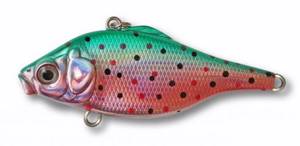
Kosadaka RAT VIB 13.4 gr. 65 mm. TR - Lucky Craft has a silver color that imitates the natural colors of river fish. Thanks to its well-chosen shape, the rattlin moves smoothly when pulling, without jerking. Lure length - 80 mm, weight - 23 g.
- River 2 sea Glassie Vibe. This model performed well when fishing at great depths. The color of the vib is silver, which predetermines its primary use in reservoirs with clear ice, where a sufficient amount of sunlight penetrates into the water column. Lure length - 65 mm, weight - 20 g.
- Madness Shiriten Vibe. This bait is distinguished from the world famous one by its excellent game and high catchability. They are available in several sizes and colors, which allows you to use Madness baits for pike perch in different conditions and at different times of the year.
- Pontoon 21 Bet-A Vib. The bait has a peculiar game that attracts the attention of an underwater predator. Perfect for fishing for pike perch from the ice, even during the dead of winter.
- Shimano Exsence Salvage. This heavy, bladeless wobbler is designed specifically for ice fishing for predatory fish at great depths. Excellent for large pike perch in winter.
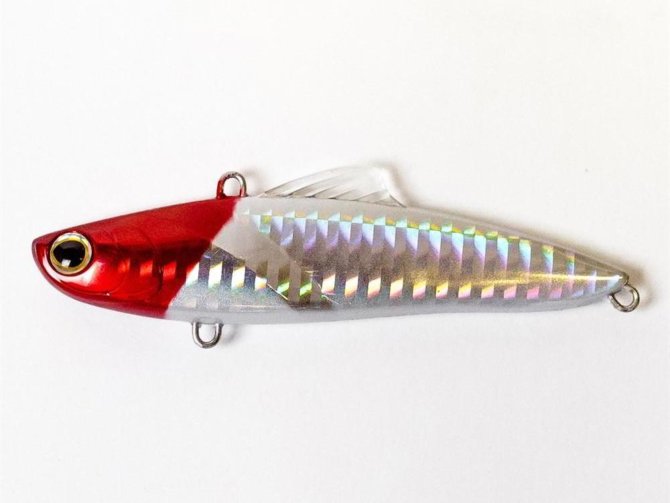
Rattlin Shimano Exsence Salvage XV-385M 26T - Rapala Rattlin. Lures produced by the Finnish company once gave the name in Russia to the entire class of bladeless wobblers. This series includes models of several sizes and colors, which allows you to choose the most suitable option for catching pike perch from the ice.
- TsuYoki. This Japanese company is one of the largest manufacturers of fishing lures. Their range includes hundreds of models. These include TsuYoki and rattlins, which are perfect for winter fishing for large and medium-sized pike perch, with a length from 65 to 100 mm.
Varieties
Rattlins differ from each other in size and shape. For each predator, fishermen have their own approach. There are an abundance of baits on sale with different colors and rattle noise levels. The place where the fishing line is attached also plays an important role, since the vibration play depends on it.
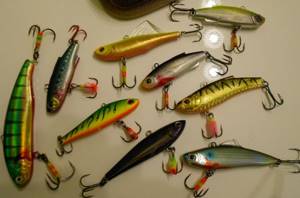
Buoyancy
The ability to glide through the water and dive quickly is of great importance when ice fishing. The baits differ in the speed at which they dive to depth. For fishing at great depths or in fast currents, you need to use a heavy vibration.
Did you know? The first metal hooks and durable silk fishing line appeared in Ancient China. The first book about the secrets of fishing was written here.
In calm waters it is better to use slowly sinking rattlins, which play more smoothly. Regular wobblers are marked SS (slow sinking) and FS (fast sinking). Rattlins are not marked that way. Tackle is distinguished by weight: 7-8 g - sinks quickly, 4-5 - slow-sinking.
Shape and size
Today there are a wide variety of shapes and sizes of baits on sale. In addition, they differ in the material of manufacture: plastic, polyurethane, silicone. For large prey, a large-sized vib is also needed; it is chosen to cut off small catches. Experienced fishermen recommend using medium-sized rattlins, approximately 5–7 cm. This gear is attractive for fish of different sizes.
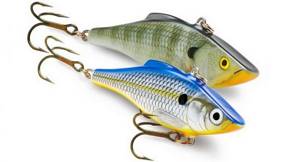
Fastening
The bite largely depends on the correct balancing of the vibration, and this indicator depends on the location of the mount. The place where the eyelet for the fishing line is located is the dorsal part . The mount can be located closer to the head, thereby increasing the range of vibrations and reducing the frequency of vibrations. When the ear moves towards the tail, the bait vibrates more often with a small amplitude of movement.
Sound of bait
Whether a rattle helps with fishing in winter or, on the contrary, hinders it, is a controversial issue. I have experience of successful bites with both noisy rattlins and silent baits. Most fishermen recommend purchasing different models. For pike or pike perch, for example, a vib with a quiet rattle is perfect.
Important! Since the predator is passive in winter, an excessively loud sound can scare it away.
Color
The color of the balancers can be either natural or acidic tones. The second option is more used as an irritant for sleepy fish. Bright reflections are clearly visible even in muddy water.
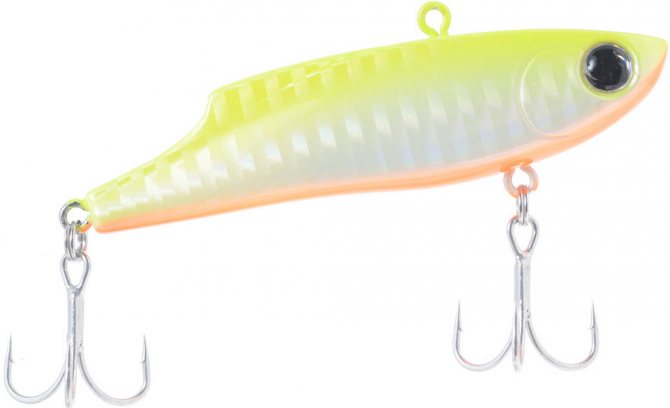
Smooth play coupled with irritating coloring not only establishes eye contact, but also provokes the predator. In any case, the color of the balancer matches the live prototype. Specifically for winter fishing, natural silver, dark green, and translucent tones are recommended.
Step by step - homemade ratlin
Perhaps I won’t “discover America,” but my article will be useful to some, especially novice wobbler builders.
Preparation
Let's start in order. First, we need to be patient, because making one wobbler can take you almost a whole day.
First of all, we need wood. to carve the blank itself (the blank from which the wobbler will be born), as well as the template from which the shape of the wobbler will be drawn. I use Cedar as wood, aspen is also suitable, but I prefer Cedar. Of course, you can “plane” a wobbler without a template, but when models appear that are more catchy than others, I make a template like this.
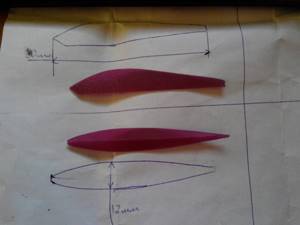
This template is not from our ratlin, it is for example.
After processing, we will get this blank for our future homemade ratlin.
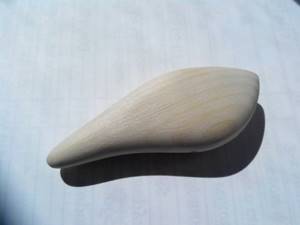
Since this is not my first ratlin model of this type, I already know in advance where and in what quantity I will mount the lead load. If this is your first ratlin then you may have to experiment.
On our ratlin we insert 2 grams into each drilled hole. lead, except for the central one, there is 3g.
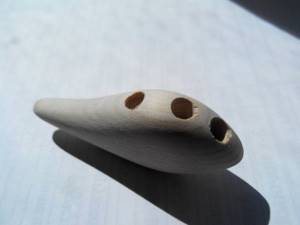
When making ratlin, you need to pay attention to the installation of hinges. If you move the carabiner loops (fasteners) too far towards the tail, then your ratlin will not work. It’s the same with a load; for a good game, the load must be in the belly of the bait. If everything goes right, then the ratlin will play and catch fish with a bang.
We glue the loops and weights.
I make several loops for attaching to the fishing line, but not in order to “guess the game of the bait,” but so that the ratlin can be used in various fishing conditions, from shallow water to vertical fishing. As you can see in the picture from above, a thin lead plate is glued into the side of the ratlin on both sides and a steel ball is inserted between the plates. Thus, a rattle-noise chamber is implemented in the Ratlin.
Primer and painting
Once the preparatory work is over and there are no pits or bumps left, everything is sanded and the cracks are sealed with auto-putty for plastic, we move on to the priming stage
As a primer I use nitro enamel NTs-11 from Yaroslavl Paints. The priming process comes down to dipping our workpiece into paint. I apply 5-7 layers with intermediate drying for 20-40 minutes. After complete drying for 1 day, the sanding process begins again. Sanding after priming is needed to create micro scratches for better retention (adhesion) of the paint layer. After processing we get this blank.
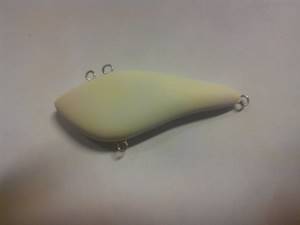
I won’t describe the painting process, it was filmed, if you have any questions about painting, I’ll answer in the comments.
Well, our ratlin is painted, but that’s not enough! For reliable protection against pike teeth, we need to protect the paint layer. As a finishing coating, following the advice of the Novokuznetsk Wobbler Manufacturers, namely KOSTA (special thanks for the advice), I use a foreign polyurethane one-component varnish MARISIL770. I use this varnish in the same way as a primer, namely, I dip the painted workpiece into the varnish. Intermediate drying time for this varnish (according to experience) is 1-2 hours. I make about 6 layers.
After complete drying and equipping our blank with all the necessary ammunition (winding rings and hooks), we get such a FIGHTER!
And this is a video game of our bait
No scales on everyone's tail!
Ivan B.
Similar articles:
DIY → Front sight from “Gamma”
With your own hands → Do-it-yourself collapsible “Cheburashkas”
Do it yourself → Do-it-yourself rubber boat repair
With your own hands → How to tie a riding fly
DIY → Adams will always help out!
How to make rattlins for winter fishing with your own hands
At home, experienced fishermen make gear from scrap materials.
This is not difficult to do; you only need a few tools and materials:
- airbrush;
- drill with a thin drill bit;
- sandpaper;
- wood cutter;
- wooden block;
- ruler;
- pencil;
- stencil paper;
- scissors;
- metal loop rings;
- lead ball d 0.2–0.4 cm;
- lead plates 6 pcs. (weight 2-3 g);
- dye;
- automotive putty;
- varnish;
- primer.
Winter fishing technique
You can take a regular fishing rod, but it is better to replace the whip with a reinforced one made of duralumin. The recommended fishing line is braided, with a diameter of 1–1.3 mm. The sinker for the fishing line is chosen based on the depth and strength of the current at the fishing site. On average, its weight is 3–11 g. In case of a snag, it is advisable to take several hooks with you, as well as a spare vibrator.
Important! In order for the paint to lay evenly and last a long time, after coating with a primer, the workpiece is sanded with coarse sandpaper.
Zander
In winter, the predator is not as active as in summer, but still goes out hunting. Pike perch are usually active at night, so the evening or night bite is best. Most often, fish “walk” at depth, so before fishing it would not hurt to familiarize yourself with the bottom topography.
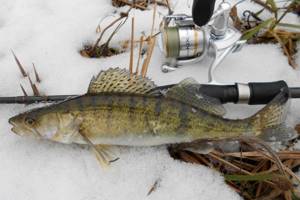
Effective tactics:
- smooth movements with a series of sharp jerks;
- every 10–12 revolutions the coils accelerate;
- It is advisable to make wiring at the very bottom.
Pike
The fish bites the bait with sweeping, but not too sudden movements. The method of searching for pike at depth often works.
The following actions show good results:
- Casting bait, reeling, uniform retrieval.
- Let the bait sink to the bottom in steps, with short stops.
- Wiring, striking along the bottom, with a slight bounce.
Video: catching pike with rattlins

Perch
For perch in winter you need a silent rattlin.
Did you know? Trout holds the record for fastest speed among freshwater fish. In pursuit of prey, the predator reaches speeds of up to 16 km/h (versus 9 km/h for others), and when jumping from the water it accelerates to 30 km/h.
Fishing technique:
- The bait is 4-5 cm long.
- Jerk with a rod up to 0.5 m in length.
- First there is a search for the horizon where the fish “walks”.
- As it sinks to the bottom, the vibration twitches slightly to create small vibrations.
- The depth at which the bite occurred is remembered, and then all manipulations with the rattlin are carried out at this level.
Trout
The predator usually occupies medium depths, but can sometimes rise under the ice. Therefore, you first need to “find” it.

Searching on “wild” and paid reservoirs has differences:
- In the first case, you need to look in shelters: snags, large stones, holes with current eddies.
- In the second - the middle of the pond, where it is deeper, there are ditches or dumps, depth differences.
Trout readily responds to moving bait. It is necessary to take into account that by clinging to the prey, the predator pulls it to depth. When hooking, you can’t loosen the line: the fish will fall off. They hook it sharply and quickly. Fishing with rattlin is gaining more and more admirers. The bait shows good results, especially when used skillfully.
Tactics for catching perch with rattlins in winter
There are two fishing options:
- Search. Ideal when the water area is unknown, or when the fish are very active. The idea is to drill a large number of holes in the ice, each of which must be quickly fished and moved on to the next.
- Catching promising points. In this option, there should not be many holes, but each one must be carefully fished. During fishing, you should go through all the holes several times. This method is suitable for well-known places, or when the perch is not active and is in no hurry to attack.
